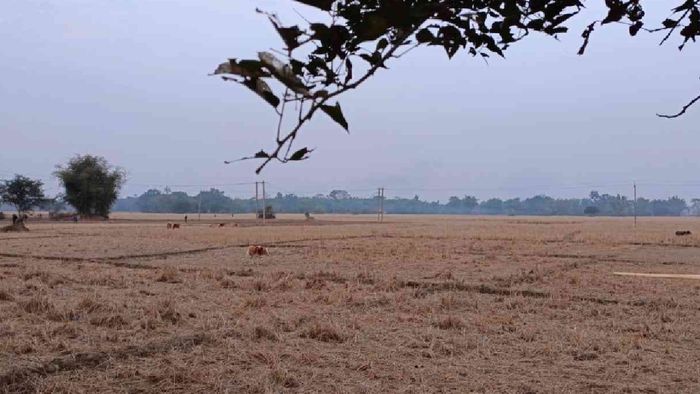Assam farmers face drought and irrigation woes amidst soaring temperatures
As Assam grapples with scorching heat and drought-like conditions, the situation for the state’s farmers is becoming increasingly dire due to inadequate irrigation facilities.

- Sep 28, 2024,
- Updated Sep 28, 2024, 1:58 PM IST
As Assam grapples with scorching heat and drought-like conditions, the situation for the state’s farmers is becoming increasingly dire due to inadequate irrigation facilities. With only 7% of the state’s net sown area receiving irrigation during the Kharif season, agricultural output is under threat, particularly for rice—the main crop of the region.
Assam is currently facing a critical agricultural crisis due to soaring temperatures and the lack of adequate irrigation facilities. As the state experiences persistent drought-like conditions, farmers are struggling to sustain their crops, particularly rice, which dominates the region's agricultural landscape.
The Agriculture Department's data reveals that out of Assam’s total net sown area of 27.5 lakh hectares, 24 lakh hectares are dedicated to rice cultivation. However, only a small fraction of this land benefits from irrigation, exacerbating the challenges posed by the adverse weather conditions. In 2021 and 2022, a mere 1.96 lakh hectares—or just 7% of the total net sown area—was irrigated during the Kharif season.
This lack of irrigation is particularly significant for Sali rice, the state’s traditional rice crop. The data indicates a notable decline in irrigation coverage for traditional Sali rice, with the irrigated area shrinking from 1.21 lakh hectares in 2021 to just 0.7 lakh hectares in 2022. However, there has been a marginal improvement in the irrigation of high-yielding variety (HYV) Sali rice, with the area under irrigation increasing from 0.6 lakh hectares in 2021 to 0.8 lakh hectares in 2022.
Despite these slight improvements, the overall situation remains precarious. Professor R.L. Deka, head of Agro-Meteorology at Assam Agriculture University (AAU), provided insights into the regional disparities in irrigation coverage. “In both the rice cultivars, it was observed that the number of districts covered under irrigation increased in 2022 compared to the previous year,” he said.
For traditional Sali rice, Chirang district led the state in irrigation coverage in 2021, with 0.27 lakh hectares under irrigation, followed by districts such as Kokrajhar, Baksa, Udalguri, and Sonitpur. In the case of HYV Sali rice, Nagaon district covered the most area in 2021, with 0.26 lakh hectares irrigated, followed by Udalguri, Baksa, Karbi Anglong, and Majuli.
To address the growing irrigation crisis, the Agriculture Department has initiated several efforts aimed at expanding irrigation coverage. Sources within the department disclosed that a significant focus has been placed on the installation of shallow tube wells (STWs) under the NABARD’s Rural Infrastructure Development Fund (RIDF) scheme. Over the past seven years, approximately 67,000 STWs have been installed across the state. These STWs are powered by solar energy, diesel, and conventional electricity, and are proving to be a popular option among farmers.
"Solar-powered STWs are gaining popularity due to the 85% subsidy provided to farmers. This has been instrumental in helping them access water in a cost-effective manner," said a source in the Agriculture Department. Furthermore, a Rs 200-crore proposal has been submitted to NABARD to expand the installation of STWs, with the aim of bringing more cropland under irrigation.
Despite these efforts, the impact on the state’s overall irrigation coverage remains limited. According to official data, only 14% of Assam’s gross sown area is covered by irrigation projects. Out of nearly 4,000 irrigation projects in the state, more than 1,500 are non-functional, further reducing the effectiveness of these initiatives. While 11.03 lakh hectares were technically brought under irrigation schemes by 2023, the actual coverage is much lower due to the large number of dysfunctional projects.
In 2022, crops were irrigated over only 5.50 lakh hectares, highlighting the gap between the intended and actual benefits of the state’s irrigation infrastructure. The Irrigation Department is now working to restore these non-functioning schemes in an effort to improve irrigation coverage for Kharif crops, grown from June to October, and Rabi crops, grown from November to May.
In the face of these challenges, agricultural scientists are advocating for the adoption of innovative water conservation techniques and more sustainable cropping patterns to mitigate the impact of drought. They emphasize the importance of maximizing in-situ water retention through rainwater harvesting and soil conservation measures.
“Farmers should be encouraged to practice rainwater harvesting through techniques such as mulching, constructing farm ponds, and developing percolation tanks. These methods can provide lifesaving irrigation to crops during critical periods of water scarcity,” explained a scientist from Assam Agriculture University.
These techniques not only ensure more efficient use of available water but also help farmers mitigate the risk of crop loss due to irregular rainfall patterns and prolonged dry spells. By focusing on sustainable water management, experts believe Assam’s agriculture sector can become more resilient to the changing climate and associated challenges.
Although efforts are underway to improve the state’s irrigation facilities, there remains a significant gap between the demand for water and the availability of irrigation infrastructure. With over 1,500 irrigation projects still non-functional and coverage limited to only a small fraction of the total agricultural land, Assam’s farmers are left vulnerable to the increasingly erratic climate conditions.
Restoring non-functioning irrigation projects, expanding the use of solar-powered STWs, and promoting innovative farming practices are all crucial steps in addressing Assam’s agricultural crisis. Without immediate and sustained efforts to improve irrigation coverage, the state risks further crop losses, threatening the livelihoods of thousands of farmers who rely on rice cultivation for their sustenance.
As the state continues to contend with extreme weather, the challenges faced by its farming community serve as a stark reminder of the urgent need for investment in sustainable agricultural practices and infrastructure.